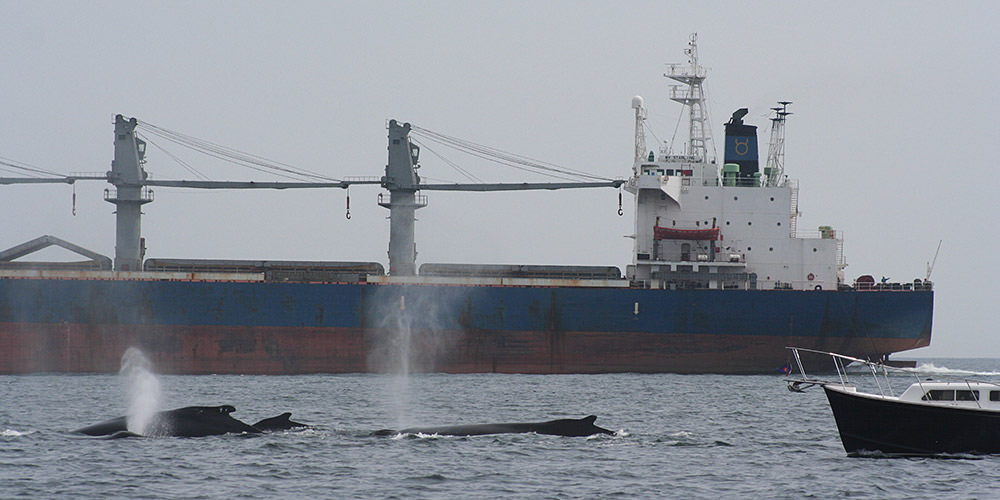
Regulations and guidelines help protect natural and cultural resources for today’s users and for future generations. Federal regulations for Stellwagen Bank National Marine Sanctuary are listed in the Code of Federal Regulations at Title 15 (Commerce and Foreign Trade), Part 922 (National Marine Sanctuary Program Regulations), Subpart N (Stellwagen Bank National Marine Sanctuary), Sections 922.140 through 922.143 (plus Appendix A).
Guidelines have no legal enforcement status but provide a recommended code of behavior that help protect marine life. Guidelines for whale watching have been developed by the sanctuary with NOAA Fisheries and the whale watching community.
The sanctuary and NOAA Fisheries have incorporated these guidelines into the See-A-Spout boater education program and Whale SENSE voluntary operation program for commercial whale watch companies.
Stellwagen Bank National Marine Sanctuary is a 638 square-nautical-mile (842-square-mile) marine protected area at the mouth of Massachusetts Bay. It encompasses all of Stellwagen Bank and Tillies Basin and Bank, and parts of Jeffreys Ledge and Stellwagen Basin. Boundary coordinates for the NE, SE, SW, WNW, and NNW points are as follows:
42 deg.45’59.83”N x 70 deg.13’01.77”W (NE);
42 deg.05’35.51”N x 70 deg.02’08.14”W (SE);
42 deg.07’44.89»W x 70 deg.28’15.44»W (SW);
42 deg.32’53.52»N x 70 deg.35’52.38»W (WNW);
42 deg.39’04.08»N x 70 deg.30’11.29»W (NNW).
A more detailed list of boundary coordinates is available in the Code of Federal Regulations.
* All Department of Defense military activities shall be carried out in a manner that avoids to the maximum extent practicable any adverse impacts on sanctuary resources and qualities. Prohibitions in 1 and 3-8 do not apply to any activity necessary to respond to an emergency threatening life, property or the environment.
Various federal authorities provide statutory responsibility for protecting marine resources, including those in or near Stellwagen Bank National Marine Sanctuary. The following statutes vary greatly in scope and approach, ranging from broad-based legislation addressing resource conservation and environmental protection to regulation of specific activities and/or resources. To learn more about how these laws apply to the sanctuary, see Appendix G of the 2010 management plan.
NOTE: A section of the eastern side of the sanctuary (often referred to as “The Sliver”) is part of the Western Gulf of Maine Groundfish Closure and Habitat Areas in which fishing activities that impact the seafloor are prohibited.
Magnuson Fishery Conservation and Management Act (MFCMA) (16 U.S.C. Part 1801 et seq.)
Atlantic Tunas Convention Act of 1975 (16 U.S.C. part 971 et. seq.)
Atlantic Fisheries Act of 1942 (more commonly known as “Atlantic States Marine Fisheries Compact”, Pub. L. 77- 539, as amended by Pub. L. 81-721.)
Atlantic Coastal Fisheries Cooperative Management Act, 16 U.S.C. § 5101 et seq. (2001)
Endangered Species Act (ESA) (16 U.S.C. Part 1531-1543.)
Marine Mammal Protection Act (MMPA) (16 USC 1361 et. seq.)
Migratory Bird Treaty Act (MBTA) (16 USC 703 et. seq.)
Clean Water Act (CWA) (33 U.S.C. 1251 et. seq.)
Rivers and Harbors Act 1899 (RHA) (33 U.S.C. 401 et. seq.)
Ports and Waterways Safety Act (PWSA) (33 U.S.C. 1231 et. seq.)
Act to Prevent Pollution from Ships (APPS) (33 U.S.C. 1901 et. seq.)
Oil Pollution Act of 1990 (OPA) (P.L. 101-380, 33 USC 2701 et. seq.)
Federal Aviation Act (49 USC 1301 et. seq.)
Clean Air Act (CAA) (42 USC 7401 et. seq.)
Outer Continental Shelf Lands Act (OCSLA) (43 USC 1331 et. seq.)
Title I of the Marine Protection, Research, and Sanctuaries Act (MPRSA) (33 USC 1401 et. seq.)
National Historic Preservation Act (NHPA) (16 USC 470 et. seq.)
Comprehensive Environmental Response, Compensation, and Liability Act (CERCLA) (42 USC 9601 et. seq.)
State agencies do not have jurisdiction in Stellwagen Bank National Marine Sanctuary as it is entirely outside state territorial waters, but these agencies can influence the quality of the sanctuary environment. To learn more about how these state statutory authorities link to the sanctuary, see Appendix G of the 2010 Management Plan.
Massachusetts Coastal Zone Management Act of 1972 (Mass. General Laws Chapter 21A, Chapter 6A, sections 2-71, 16 USC 1451 et. seq.)
Massachusetts Ocean Sanctuaries Act (Mass. General Laws Chapter 132A, section 12A – 16F, 18)
Wetlands Protection Act (Mass. General Laws Chapter 131, section 40)
Massachusetts Environmental Policy Act (Mass. General Laws Chapter 30, sections 61-62H)
Massachusetts Public Waterfront Act (Mass. General Laws Chapter 91)
Massachusetts Clean Water Act (Mass. General Laws Chapter 21, Section 26-53)
Massachusetts Board of Underwater Archaeological Resources (Mass. General Laws Chapter 6, Sections 179- 180; Chapter 9, Section 26; Chapter 11D’ Chapter 30, Section 61; Chapter 91, Section 63, 72)